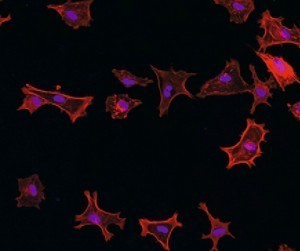If germs enter a wound, they can trigger an infection that may not heal or even develop into life-threatening blood poisoning (sepsis). The problem of antibiotic resistance is particularly acute in complex wounds. Empa researchers have therefore developed cellulose membranes that can be used to nip such infections in the bud.
 In the presence of the multifunctional protein building blocks of a cellulose surface, human connective tissue cells (fibroblasts) adhere better, as hoped, and begin to distribute themselves evenly.The team led by Empa researcher Katharina Maniura from the Biointerfaces Laboratory in St. Gallen produced fine membranes from plant cellulose using electrospinning. The cellulose fibers with a diameter of less than one micrometer were spun into a delicate three-dimensional fabric in several layers. The membranes became particularly flexible and at the same time stable after the researchers had also spun in the polymer polyurethane.
In the presence of the multifunctional protein building blocks of a cellulose surface, human connective tissue cells (fibroblasts) adhere better, as hoped, and begin to distribute themselves evenly.The team led by Empa researcher Katharina Maniura from the Biointerfaces Laboratory in St. Gallen produced fine membranes from plant cellulose using electrospinning. The cellulose fibers with a diameter of less than one micrometer were spun into a delicate three-dimensional fabric in several layers. The membranes became particularly flexible and at the same time stable after the researchers had also spun in the polymer polyurethane.
In order to achieve an antibacterial effect, the researchers developed multifunctional protein building blocks - peptides - that can bind to the cellulose fibers and also have antimicrobial activity. These peptides have the advantage that they are easier to produce and remain more stable than larger proteins, which are more sensitive to chemical conditions.
When the cellulose membranes were treated with such a peptide solution, the fiber scaffold became saturated with the protein building blocks. In cell culture experiments, the researchers then demonstrated that the peptide-containing membranes are well tolerated by human skin cells. For bacteria such as staphylococci, however, which are often found in poorly healing wounds, the cellulose membranes were a death sentence. In bacterial cultures, over 99.99 % of the germs were killed by the peptide-containing membranes.
In the future, the antimicrobial membranes will also be equipped with additional functions. For example, the peptides can be functionalized with binding sites that enable the controlled release of other therapeutic agents.
Source: Empa


